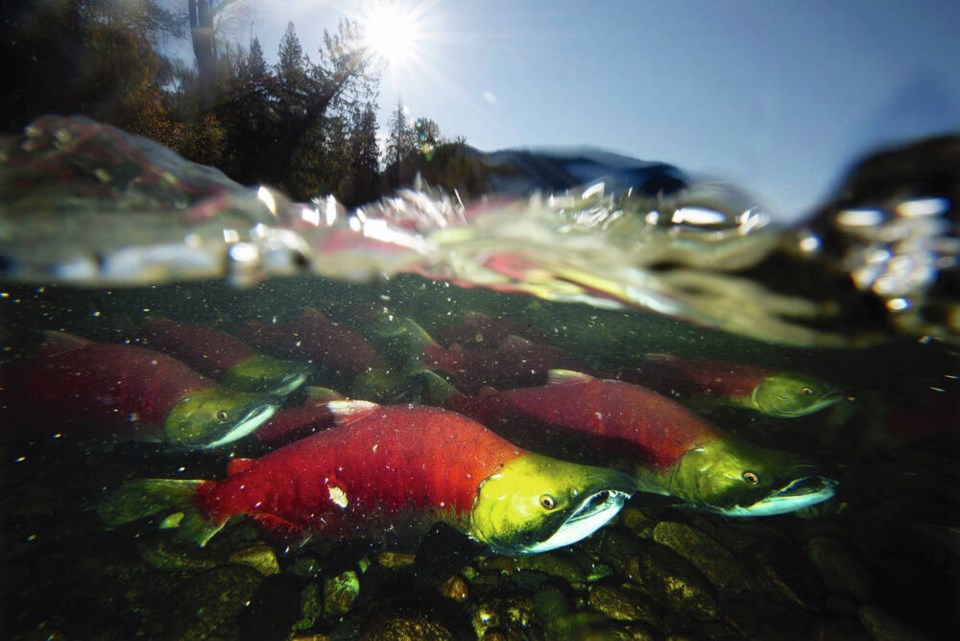Researchers are warning that marine heat waves made more extreme and more frequent by climate change could wipe out up to half of the Canada’s Pacific salmon catch by 2050.
A study, led by a group of researchers at the University of British Columbia and published in the journal Science Advances, modelled the trajectories of 10,088 fish and invertebrates across the planet’s oceans.
“It will have particular affect on coastal communities, especially First Nations communities that rely on salmon,” said William Cheung, director of the Institute for Oceans and Fisheries at UBC and the study’s lead author.
Overall, it found that 77 per cent of fish and other seafood that’s harvested is expected to decrease in the coming decades. That’s expected to lead to a significant loss in fisheries revenue in countries where thousands of people rely on the sea for their livelihoods.
In Ecuador, rising ocean temperatures were already expected to lead to a 25 per cent decrease in fisheries revenue; marine heat waves are projected to drop the country’s annual catch by another 10 per cent.
Low-lying Bangladesh is threatened by rising sea level. The study projects that the country’s fisheries-related workforce — which employs roughly a third of all workers — will hemorrhage over a million jobs by 2050 due to extreme ocean heat events. And in Indonesia, a further three million jobs are expected to disappear by mid-century.
“It will definitely have impact on fish supply globally,” Cheung said. “That directly impacts people here.”
“Canadians consume seafood, but we get fish from all over the world. If you go to the supermarket and go to the frozen seafood section, most of the seafood is from one of those tropical regions — Indonesia or Thailand.”
While over 10,000 species were included in the projections, any species not important to fisheries was excluded. Cheung said that leaves huge data gaps for an untold numbers of marine animals who will inevitably be hit equally as hard by warming seas.
But not all species will be negatively affected by marine heat waves, said Cheung. Tuna, for example, like warm water and increase their distribution as sea temperatures rise.
“The thing is, we’re already seeing some of these changes happening. In the high-temperature events in the last few years — what we call the ‘warm blob’ — we’re seeing some of these tuna species in the Northeast Pacific, including B.C.,” Cheung said.
He said it’s incumbent on countries such as Canada to take action. “We can moderate the effects on the fish stocks, so that it can … sustain them until we are capable of reducing long-term emissions.”
That means better data collection to get rapid understanding of the number of fish in a given season as well as restrictions on commercial catches.
That future is already here.
The Fraser River — Canada’s most important salmon-bearing river — averaged 9.6 million sockeye returns annually between 1980 and 2014, with up to 28 million one year. In 2020, salmon returning to the Fraser River fell to an all-time record low of 293,000. The 2019 return set the previous low record at 485,000.
Cheung said as climate change affects these returns even more, the province is only going to see more fisheries close.
“It’s scary but it lines up with what people have been seeing in their streams and rivers across B.C.,” Aaron Hill, executive director of the Watershed Watch Salmon Society, said of the latest research.
Hill spoke to Glacier Media while on the banks of the Skeena River, where chinook fisheries faced total closure in June, and where record-low returns of steelhead could soon mean they will face their first closure ever.
“These are just examples of unprecedented change we’re seeing here in B.C.,” he said. “It underscores the importance of doing all the things we already know, give salmon the best chance to survive and thrive in the face of climate change.”
That includes creating endangered species recovery plans, protecting and restoring freshwater habitat, moving fish farming into land-based pens and responsibly managing hatcheries so the problem doesn’t get worse, Hill said.
In June, Ottawa pledged nearly $650 million over five years to roll out such measures to restore salmon populations, but few details have been released about how and where the money will be spent.
There are positive signs conservation efforts are paying off. This summer, the federal government closed 60 per cent of commercial salmon fisheries. On the Skeena, Hill said he is seeing some abundance return to the river this year.
“But that was in the absence of commercial fishing on the coast, at the mouth of the rivers,” he said. “It actually does work.”



